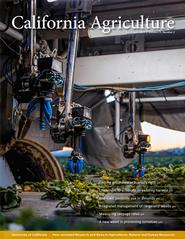All Issues

A robotic harvester manufactured by advanced.farm gently picks a strawberry from a plant on a ranch in Oxnard. Photo: Visionary Photography c/o advanced.farm
Volume 75, Number 2
News and opinion
Groundwater markets are a promising tool for basins implementing SGMA, but they are complex, and good design is essential.





